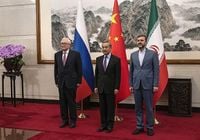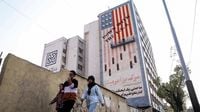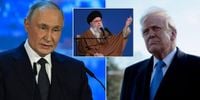In a dramatic turn of events, U.S. President Donald Trump has sent a letter to Iran’s supreme leader, Ayatollah Ali Khamenei, expressing interest in reviving nuclear negotiations. This overture comes at a time of heightened tensions between the two nations, as Iran continues to expand its nuclear program amid threats from the U.S. to take military action.
The letter, which was delivered to Iranian Foreign Minister Abbas Araghchi by an Emirati official on March 12, was not made public. However, Trump revealed in a March 7 interview with Fox News that the letter included a plea for Iran to negotiate. He ominously warned, “I hope you’re going to negotiate because if we have to go in militarily it’s going to be a terrible thing.”
Upon receiving the letter, Khamenei dismissed the proposal, stating that Iran is not interested in talks with what he termed a “bullying government.” He characterized the U.S. military threats as “irrational” and cautioned that Iran is capable of delivering a “reciprocal blow.” This skepticism reflects a broader sentiment within Iran regarding U.S. intentions, especially given the historical context of their fraught relationship.
In a speech delivered on March 29, Iranian President Masoud Pezeshkian reiterated that Iran had rejected the possibility of direct talks but left the door open for indirect negotiations. This nuanced position suggests that while Tehran may be wary of direct engagement with the U.S., it is not entirely dismissive of diplomatic avenues.
National Security Advisor Michael Waltz has indicated that the U.S. aims to pressure Iran into dismantling its entire nuclear program. In a March 16 interview with ABC News, he stated, “Iran can either give up its nuclear program, including its uranium enrichment activities, in a way that is verifiable or face a whole series of other consequences.” This stark ultimatum underscores the U.S. administration’s hardline stance.
Iran’s response to the escalating tensions has been to engage with its allies. On March 14, Iranian officials met with their counterparts from China and Russia in Beijing to discuss the nuclear issue. Following the meeting, the three nations issued a joint statement calling for the termination of “all unlawful unilateral sanctions” and emphasizing the need for dialogue based on “mutual respect.” This reflects Iran’s strategy of seeking support from global partners amid increasing pressure from the U.S.
Adding to the complexity of the situation, Trump has asserted that he will hold Iran “fully accountable” for any actions by Houthi militants that threaten shipping lanes and U.S. interests. This statement came after large-scale U.S. airstrikes began targeting Houthi-controlled areas of Yemen on March 15. The Houthis have ramped up their military activities following Israel’s announcement to block aid to Gaza, further complicating the regional dynamics.
Despite Iran’s military support for the Houthis, the extent of its influence over their actions remains uncertain. Trump has claimed that the Houthi attacks “all emanate from, and are created by, IRAN,” reinforcing the narrative of Iranian aggression that the U.S. has employed in its justification for military readiness.
The backdrop to these developments includes a troubling report from the International Atomic Energy Agency (IAEA) released on February 26, which noted a significant increase in Iran’s stockpile of uranium enriched to 60 percent U-235, a level close to weapons-grade material. The report indicated that Iran produced 91 kilograms of this enriched uranium over the past quarter, raising its total stockpile to 275 kilograms.
In response to these alarming developments, France, Germany, and the United Kingdom issued a joint statement on March 4, calling the increase in enriched uranium “alarming” and reiterating their commitment to a diplomatic solution. IAEA Director-General Rafael Mariano Grossi has also called for high-level engagement with Iran, emphasizing the need for concrete results regarding the agency’s ongoing investigation into Iran’s past nuclear activities.
As Trump navigates these treacherous waters, his administration’s approach to Iran seems to embody a shift from outright hostility to a more nuanced, albeit still confrontational, stance. While he has expressed a willingness to negotiate, the framing of these negotiations as contingent upon Iran’s compliance with stringent demands has created a binary choice for Tehran: engage or face military repercussions.
Iran’s military exercises conducted in January and February 2025, code-named "Eqtedar-1403," reflect its heightened threat perception. These exercises were designed to test Iran’s air defense capabilities and counterattack scenarios, indicating a preparedness for potential military confrontations.
The Iranian government is currently grappling with a complex dilemma. On one hand, it faces the pressure to negotiate with the U.S. under terms that may compromise its strategic interests. On the other, it risks destabilizing its regime by appearing to capitulate to external demands. This precarious balance has led to significant internal debate within Iran, particularly among conservative factions that remain skeptical of negotiations.
Supreme Leader Khamenei’s characterization of the U.S. as an unreliable actor and his emphasis on the deceptive nature of negotiations underscore the internal divisions regarding engagement with Washington. The resignation of Vice President Javad Zarif, who favored negotiations, further complicates the landscape, leaving the Iranian leadership at a crossroads.
As the situation unfolds, the international community watches closely. The stakes are high, and the potential for miscalculation remains significant. The interplay of military posturing, diplomatic overtures, and regional alliances will shape the future of U.S.-Iran relations in the coming months.






